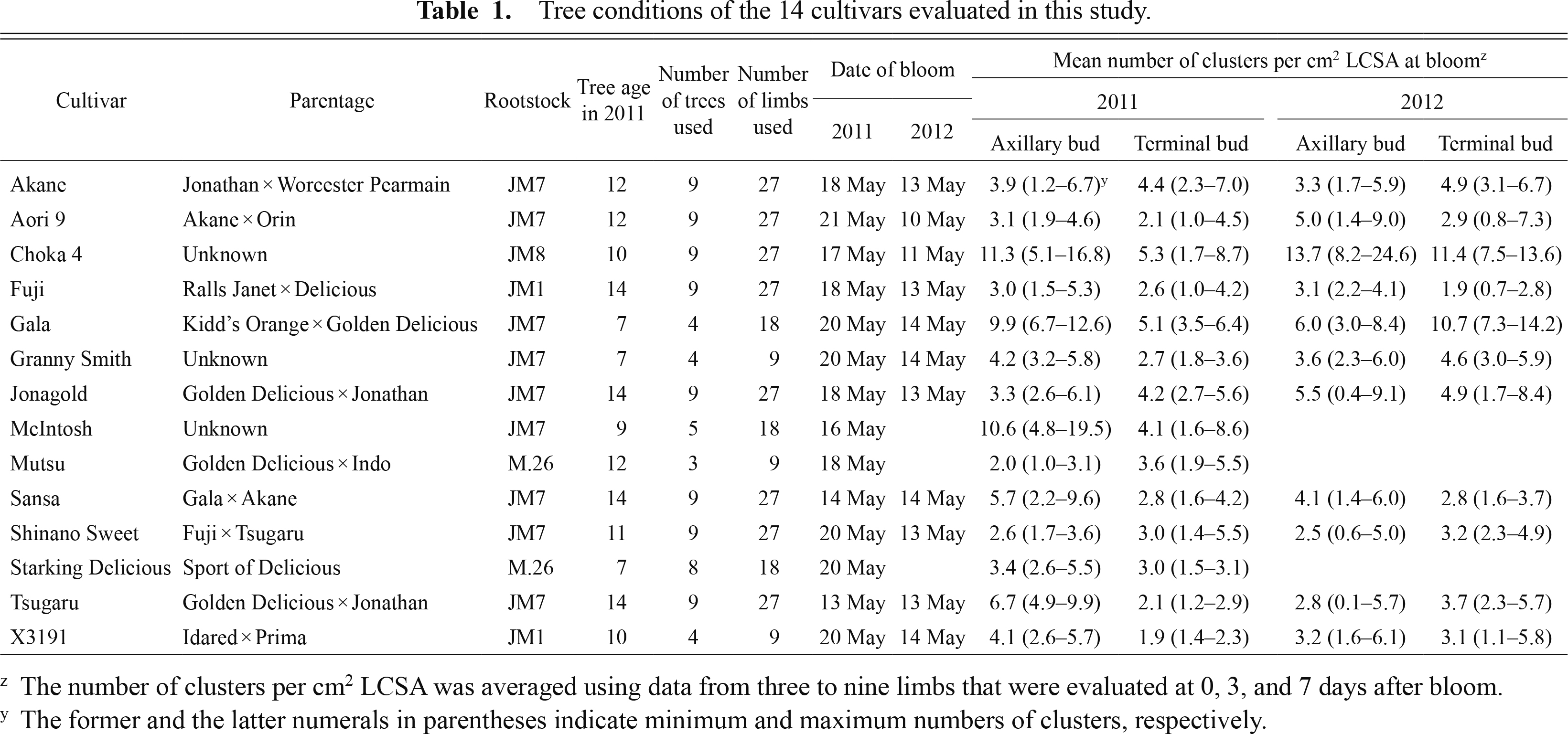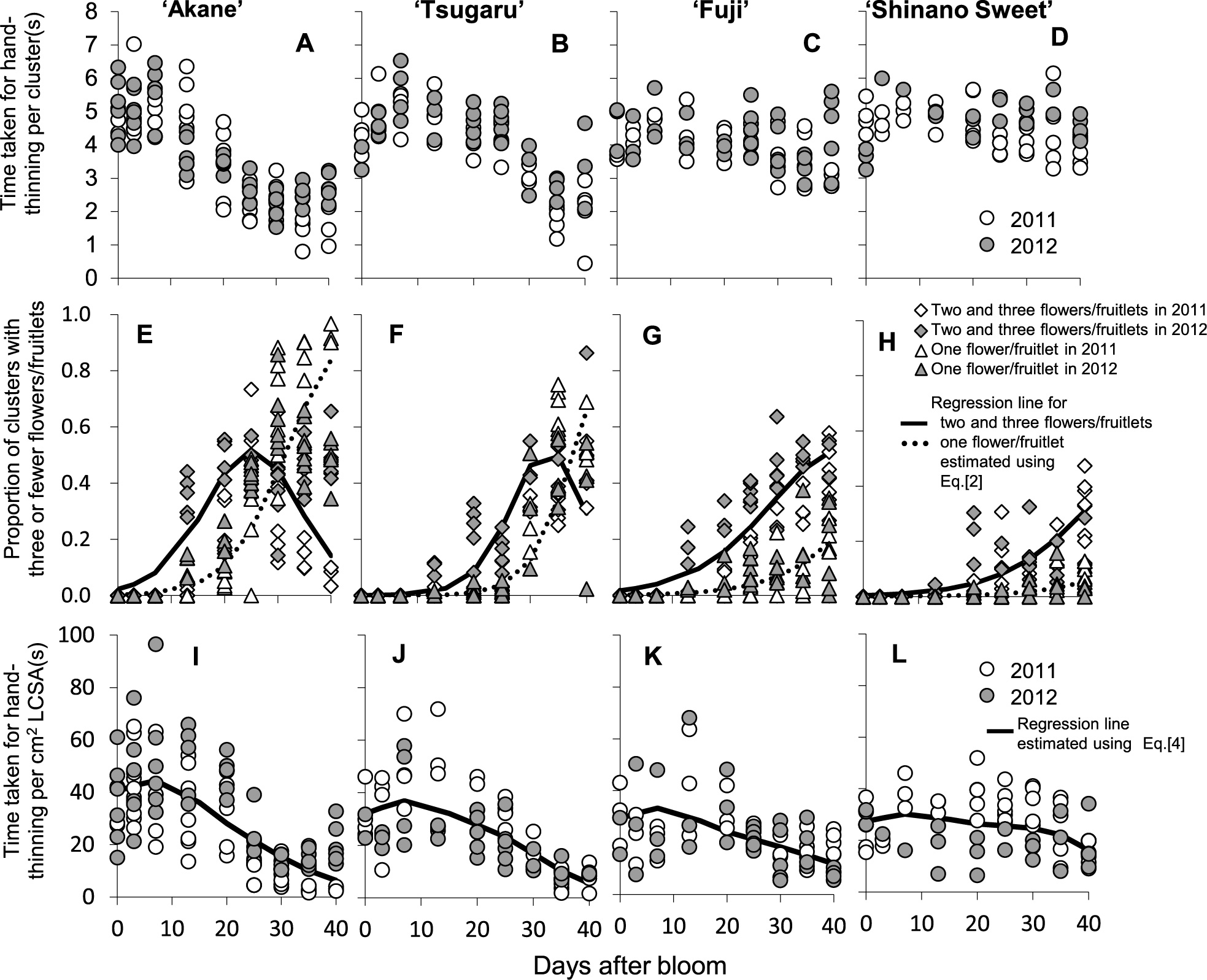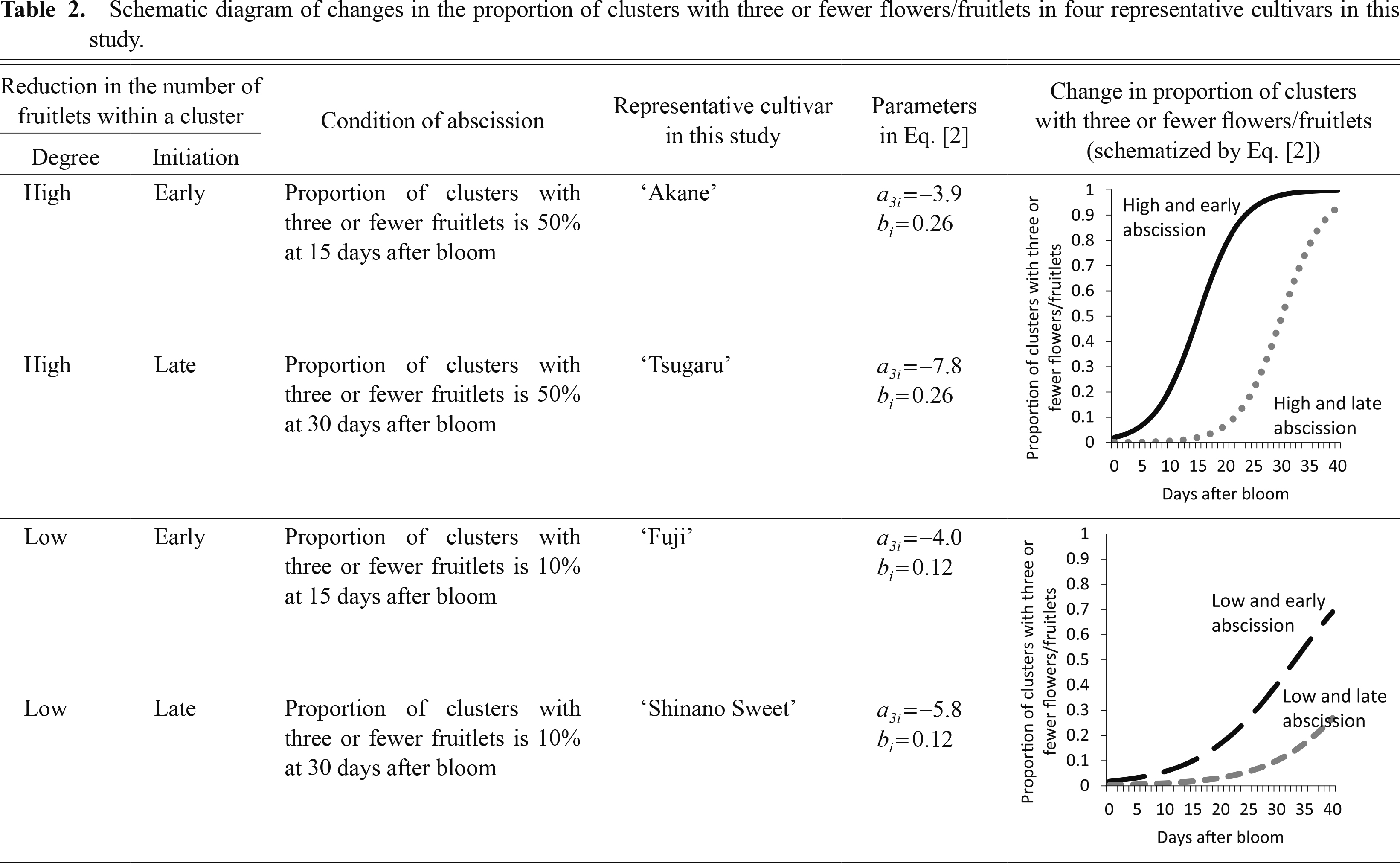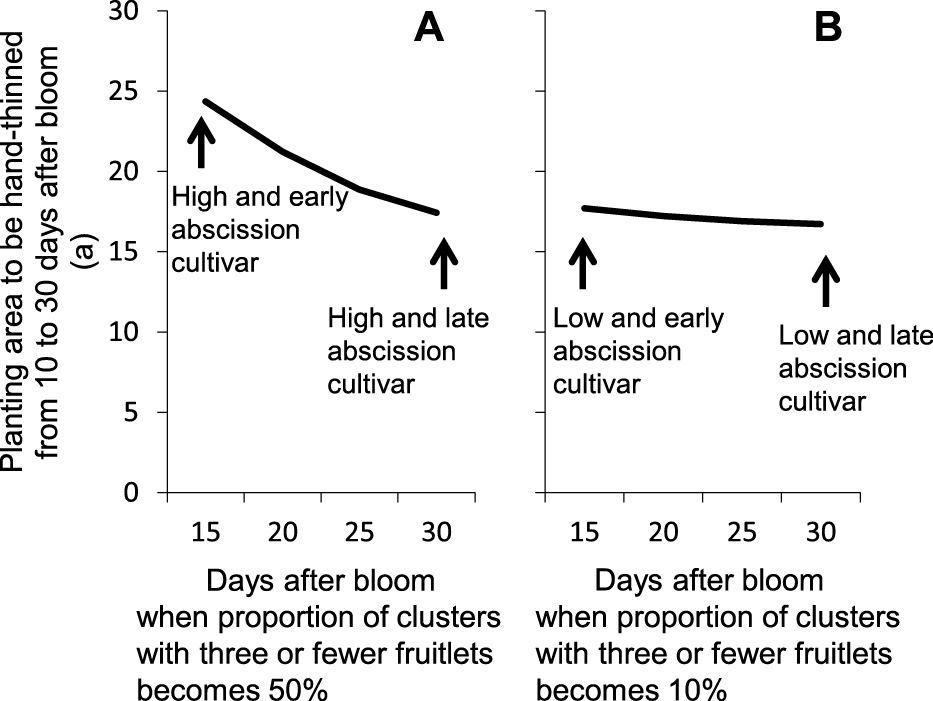2015 年 84 巻 2 号 p. 99-105
2015 年 84 巻 2 号 p. 99-105
The thinning of flowers or fruit is an essential part of the commercial production of quality apples. Although chemical thinners are generally used in apple orchards throughout the world, hand-thinning remains essential for controlling crop load to improve fruit quality and return bloom. The objectives of this study were to investigate factors that determine the time required for hand-thinning and to elucidate cultivar-related efficiency of hand-thinning. In all cultivars, the time taken for hand-thinning per cluster became shorter after petal fall, but the degree of this decrease differed among cultivars. The time taken for hand-thinning depended on both how much and when natural abscission of fruitlets occurred. The times required for hand-thinning were very similar among clusters with four, five, or six flowers/fruitlets, which was twice as long as that required for clusters with two or three flowers/fruitlets. This means that the time required for hand-thinning clusters is critically reduced when the number of flowers/fruitlets within a cluster is three or fewer. The time required for hand-thinning clusters of axillary buds became significantly longer from bloom to 7 days after bloom, and then decreased gradually from 7 to 25 days after bloom. When the proportion of clusters with three or fewer fruitlets is 50% at 15 days after bloom, the planting area of the cultivar that a person is able to hand-thin (six hours per day) from 10 to 30 days after bloom was 24.3 a, which was 40% larger than that of a cultivar in which the proportion of clusters with three or fewer fruitlets is 50% at 30 days after bloom (17.4 a). Therefore, the introduction of cultivars in which fruit abscission occurs at an early stage and on a large scale is a solution for reducing the labor costs of hand-thinning.
The thinning of flowers or fruit is an essential part of the commercial production of quality apples (Malus × domestica Borkh.). Chemical thinners have long been used in apple orchards to reduce the cost of hand-thinning (Byers, 2003). Thinning at bloom time results in improved fruit size, increased return bloom, and promotes regular bearing (Wertheim and Webster, 2005). However, fruit bearing may be at risk if the consequently smaller numbers of flowers are further reduced by spring frosts, or if rainy or cold weather conditions prevent pollinators from visiting flowers during bloom. For these reasons, there has been growing reluctance to reduce flowers by using chemical thinners before bearing (Greene, 2002). Most chemical thinners are applied between 7 and 21 days after bloom. The greatest problem with chemical thinning is the inconsistency of the response, due in part to the effects of various environmental and tree factors (Greene, 2002; Wertheim, 2000). Follow-up thinning by hand is typically required if the effects of chemical thinners are insufficient and large numbers of fruit remain on trees.
In the Japanese fresh fruit market, larger fruit command higher prices. For this reason, it is recommended that producers complete fruit thinning by 30 days after full bloom (Koike et al., 2003). To produce fruit greater than 300 g in weight, Japanese growers start to thin fruit by hand after petal fall, leaving only the fruitlet in the king flower position on a cluster (Fukuda, 1994). Although Japanese growers typically use chemical thinners in large-scale orchards, they often start hand-thinning before fruit drop occurs, which is induced by the application of chemical thinner, because thinning could not be completed by 30 days after full bloom if it is started after the fruit drop. Therefore, chemical thinners are primarily used to supplement hand-thinning in Japan.
Improving the efficiency of hand-thinning programs has not been given serious consideration because chemical thinners are available throughout the world. The labor required for flower or fruit thinning, including work related to pollination, is 750–820 h·ha−1 for the average apple grower in Japan (Fukuda, 1994). In organic apple production in other countries, hand-thinning is estimated to require 100–300 h·ha−1 (Lind et al., 2003; Weibel and Häseli, 2003). In contrast, only 83 h·ha−1 was required for fruit thinning when using chemical thinners in a high-density orchard in the USA (Glover et al., 2002).
The number of flowers or fruit on a tree has a large influence on the time required for hand-thinning. The number of flowers/fruit on a tree is highest at full bloom and is reduced during two periods of abscission: flowers that are not fertilized abscise soon after flowering and second abscission occurs 4–6 weeks after full bloom (June drop) (Dennis, 2003). The timing of natural fruit abscission and the degree of fruit abscission after fertilization vary greatly among cultivars (Iwanami et al., 2012). This means that the time required for hand-thinning also varies among cultivars. The introduction of cultivars with the abscising of many fruitlets in an orchard is considered to be effective for reducing the labor costs of hand-thinning. Therefore, the objectives of this study were to determine the influences of the timing of natural fruit abscission and the degree of fruit abscission on the time required for hand-thinning and to elucidate cultivar-related efficiency of hand-thinning.
Fourteen cultivars from orchards at the Apple Research Station, NARO Institute of Fruit Tree Science, Japan, were used (Table 1). The cultivars were selected so as to generate a wide range in terms of the number of flowers or fruit on a tree after bloom. The fruit of ‘Aori 9’, ‘Choka 4’, ‘Akane’, ‘Mutsu’, ‘McIntosh’, ‘Tsugaru’, ‘Jonagold’, ‘Starking Delicious’, ‘Granny Smith’, and ‘X3191’ abscise roughly 6 weeks after bloom, whereas the fruit of ‘Fuji’ and ‘Shinano Sweet’ show very little abscission. In the ‘Sansa’ cultivar, abscission occurs early after bloom, but to a reduced degree compared with that in other cultivars. Finally, excessive flower clusters are observed every year in the ‘Gala’ cultivar. Three to nine trees from each cultivar were used. Each cultivar had been planted in a row at spacing of 3 × 5 m, surrounded by rows of different compatible cultivars. Fruiting of all cultivars used in this study is stable every year under natural conditions. All trees were managed in accordance with standard orchard practices. Eleven of the 14 cultivars were studied during two consecutive years (2011 and 2012) using the same trees.

Tree conditions of the 14 cultivars evaluated in this study.
Up to 27 limbs (10–20 cm in circumference) were selected in each cultivar, depending on the number of trees used, and tagged before bloom. Each limb had 150–300 flower clusters. The numbers of flower/fruit clusters arising from the terminal and axillary buds were counted individually, and the number of flowers/fruitlets within a cluster was counted in every cluster of the terminal bud on a tagged limb before thinning. Hand-thinning was carried out during nine periods: at bloom and then at 3, 7, 15, 20, 25, 30, 35, and 40 days after bloom. The time taken for thinning during each session was recorded. Hand-thinning was carried out according to local recommendations for expert apple growers, as follows. Clusters of axillary buds were all removed. Adjacent clusters were thinned to create spaces such that the clusters were 20 cm apart. The flower/fruitlet in the king flower position on the remaining clusters of terminal buds was left, but all other flowers/fruitlets on these clusters were removed.
Hand-thinning was carried out by three hired workers who had been engaged in the practice of hand-thinning for more than 300 h per year for more than three years. Each worker performed hand-thinning nine times, from bloom to 40 days after bloom, in each cultivar.
Model for estimating the time required for hand-thinningThe time required for hand-thinning is influenced by the number of flowers/fruitlets within a cluster. To estimate the contribution of the number of flowers/fruitlets within a cluster to the time taken for hand-thinning, a seven-order model was developed:
| (1) |
Because non-fertilized flowers and weak fruitlets are naturally abscised, the number of flowers/fruitlets within a cluster decreases after bloom. Changes in the number of flowers/fruitlets within a cluster were estimated in each cultivar using a proportional odds model expressed as:
| (2) |
The number of clusters itself decreases after bloom when all flowers/fruitlets within a cluster fall. Changes in the number of clusters per cm2 of limb cross-sectional area (LCSA) were estimated for each cultivar using a logistic regression model expressed as:
| (3) |
The time required for hand-thinning changes with days after bloom because the number of clusters and the number of flowers/fruitlets within a cluster are reduced. From the parameters estimated using the above equations, changes in the time required for hand-thinning were simulated by a model expressed as:
| (4) |
Fruit thinning usually starts after flowers can be judged to have been fertilized (about 10 days after full bloom) and it is recommended that it is completed by 30 days after full bloom. Therefore, we compared a planting area that a person was able to hand-thin (six hours per day) from 10 to 30 days after bloom, assuming that 80 trees per 10 a (spacing of 2.5 × 5 m) with 80 cm2 trunk cross-sectional areas (TCSA, equivalent to LCSA) were planted. These cultivation conditions are common for apple orchards in Japan and yield 3.8 tons per 10 a when the crop load of the trees is two fruit per cm2 of TCSA and the fruit weigh 300 g on average. The planting area was expressed as:
| (5) |
The numbers of clusters per cm2 of LCSA at bloom differed considerably among the cultivars (Table 1). The minimum number of clusters that arose from axillary and terminal buds was 5.0 (3.1 from axillary and 1.9 from terminal buds) in ‘Fuji’ and the maximum was 25.1 (13.7 from axillary and 11.4 from terminal buds) in ‘Choka 4’ in 2012. The number of fruit per cm2 of LCSA after hand-thinning was around 2.0, irrespective of the cultivar, in either year (data not shown).
The time taken for hand-thinning per cluster became shorter as days passed after petal fall (7 days after bloom) in all of the cultivars, but the degree of this reduction differed among the cultivars. Changes in the time taken for hand-thinning per cluster are shown in Figure 1 for four cultivars that showed typical patterns of change. The changes displayed the same patterns for two years, indicating that the time taken for hand-thinning depended on the cultivars. The time taken for hand-thinning decreased rapidly from 15 to 25 days after bloom in ‘Akane’ (Fig. 1A). This reduction was observed between 25 and 35 days after bloom in ‘Tsugaru’ (Fig. 1B). On the other hand, the time taken for hand-thinning was only slightly reduced even at 40 days after bloom in ‘Fuji’ and ‘Shinano Sweet’ (Fig. 1C, D).

Changes in the time taken for hand-thinning per cluster, proportion of clusters with three or fewer flowers/fruitlets, and time taken for hand-thinning per limb cross-sectional area (cm2 of LCSA) after bloom in ‘Akane’ (A, E, and I, respectively), ‘Tsugaru’ (B, F, and J), ‘Fuji’ (C, G, and K), and ‘Shinano Sweet’ (D, H, and L).
To clarify the factors that affected this decrease, the time required for hand-thinning was estimated separately for clusters that had different numbers of flowers/fruitlets. The times required for the hand-thinning of clusters with different numbers of flowers/fruitlets, which were expressed as the coefficients βkj in Eq. [1], were estimated by combining data from the period when these coefficients were not significantly different. The results indicated that the time required for hand-thinning was not significantly influenced by the growing period in clusters of terminal buds with any number of flowers/fruitlets from bloom to 40 days after bloom (Fig. 2). The times required for hand-thinning were very similar among clusters with four, five, or six flowers/fruitlets, being twice as long as that required for clusters with two or three flowers/fruitlets, which began to appear from 15 days after bloom. The time required for the hand-thinning of clusters of axillary buds became significantly longer from bloom to 7 days after bloom, and then decreased gradually from 7 to 25 days after bloom (Fig. 2). Flowers within an axillary bud cluster were attached to each other at bloom and were separated at 7 days after bloom. Because all of the flowers need to be removed from the clusters of axillary buds, flowers attached to each could be removed more quickly than flowers that were separated within a cluster. The number of flowers within the cluster of an axillary bud decreased gradually, and the time required for the hand-thinning of these clusters became shorter.

Time required for hand-thinning in clusters with different numbers of flowers/fruitlets. The times were estimated using 14 cultivars that were studied for two consecutive years, which are listed in Table 1.
The time required for the hand-thinning of clusters was dramatically reduced when the number of flowers/fruitlets within a cluster was three or fewer (Fig. 2). In fact, the reduction in the time taken for hand-thinning per cluster coincided with the increase in the proportion of clusters with three or fewer flowers/fruitlets (Fig. 1E–H). Therefore, differences among cultivars in the change in time taken for hand-thinning were determined by the timing of when the proportion of clusters with three or fewer flowers/fruitlets increased as a result of natural abscission, and by the degree of this increase.
The regression model described in Eq. [4] was applied to the change in time taken for hand-thinning per cm2 of LCSA. Because the times required for hand-thinning were not significantly different among clusters with four, five, and six flowers/fruitlets and between clusters with two and three flowers/fruitlets (Fig. 2), the coefficients of Eq. [1] in the terminal buds were estimated again by combining the number of clusters with four, five, and six flowers/fruitlets, and two and three flowers/fruitlets (β4j = β5j = β6j = 5.12, β2j = β3j = 2.54, β1j = 0.91 in Eq. [1]). The results indicated that the estimated regression lines showed a good fit with the actual time taken for hand-thinning in the four representative cultivars (Fig. 1I–L).
We compared the planting area that a person was able to hand-thin from 10 to 30 days after bloom in four representative types of cultivar described in Table 2. The planting area, which was calculated using Eq. [5], was 24.3 a in the cultivar of the high and early abscission type (Fig. 3A). This area was 40% larger than that of the high and late abscission cultivar (17.4 a). In the case that the degree of reduction in the number of flowers/fruitlets was high, the planting area to be hand-thinned grew larger as the time of initiation of the reduction became earlier. On the other hand, when the degree of reduction in the number of flowers/fruitlets was low, the difference in the planting area was not large between early and late cultivars, in terms of the time of initiation of the reduction (Fig. 3B).

Schematic diagram of changes in the proportion of clusters with three or fewer flowers/fruitlets in four representative cultivars in this study.

Estimated planting area that a single person is able to hand-thin from 10 to 30 days after bloom (six hours per day) in cultivars in which the degree of reduction in the number of flowers/fruitlets and the time of initiation of this reduction vary. The areas are estimated using Eq. [5], (A) when the degree of reduction is high (bi = 0.26, in Eq. [2]) and (B) when the degree of reduction is low (bi = 0.12).
This two-year research project revealed that the overall mean time taken for hand-thinning was 29.4 seconds per cm2 of LCSA up to 40 days after bloom. The resulting labor requirement for hand-thinning was estimated to be 532 h·ha−1 under common cultivation conditions (mentioned above) in Japan. This labor requirement is generally consistent with that of fruit thinning estimated for a high-density ‘Fuji’ orchard in Japan (580 h·ha−1; Koike and Ono, 1998). The time required for hand-thinning blossoms was also measured in a high-density orchard in Canada, where it was estimated to be 227–454 h·ha−1 (2.2–4.2 min/tree; Hampson and Bedford, 2011). One of the reasons why fruit thinning requires a longer time in Japan is that Japanese growers spend considerable time selecting a good-quality king fruitlet from among adjacent clusters to produce fruit that weigh more than 300 g.
The time taken for hand-thinning depended on both how much and when the abscission of fruitlets occurred (Fig. 1). The planting area that a person is able to hand-thin (six hours per day) from 10 to 30 days after bloom was considerably large in a cultivar in which the degree of reduction in the number of flowers/fruitlets was high and the initiation of the reduction occurred at an early stage, compared with those of the other cultivars (Table 2; Fig. 3). The planting areas to be hand-thinned did not differ markedly among cultivars with high and late, low and early, and low and late abscission. These cultivars are represented by ‘Tsugaru’, ‘Fuji’, and ‘Shinano Sweet’, respectively (Table 2), which are major cultivars in Japan. Therefore, cultivars in which fruit abscission occurs on a large scale and at an early stage contribute to reducing the thinning time if growers aim to finish hand-thinning by 30 days after full bloom. ‘Aori 9’ is a cultivar in which fruit abscission occurs on a large scale and at an early stage, like ‘Akane’ (Iwanami et al., 2012). These two cultivars are often called self-thinning cultivars in Japan. The areas of cultivation of these self-thinning cultivars ‘Akane’ and ‘Aori 9’ unfortunately account for only 0.12% (46.2 ha) and 0.02% (8.8 ha) of the total apple-growing area in Japan, respectively (MAFF, 2014; http:// www. maff. go. jp/j/tokei/kouhyou/tokusan_kazyu/index.html, November 20, 2014). The introduction of self-thinning cultivars to apple orchards is a solution to reduce the labor costs of hand-thinning.
Chemical thinners are used in apple orchards throughout the world. However, most current chemicals provide insufficient thinning to satisfy the needs of fruit growers (Wertheim, 2000). The reasons for this poor response include unpredictable fluctuations in the temperature following thinner application, which is the dominant factor influencing the response to a chemical thinner (Greene, 2002), as well as the weather-dependent sensitivity of a tree to a chemical thinner, which is related to the balance between the supply and demand of carbohydrates in the tree (Lakso et al., 2006). Consequently, hand-thinning following chemical thinning remains essential for controlling crop load to improve fruit quality and return bloom (Dennis, 2000). In our study, the time required for hand-thinning was dramatically reduced when the number of fruitlets within a cluster was three or fewer (Fig. 2). Therefore, selecting a chemical thinner that reduces the number of fruitlets within a cluster to three or fewer and applying the thinner selectively on cultivars in which fruitlets show reduced abscission (e.g., ‘Fuji’ in our study) can be effective for reducing the cost and time of thinning. Flower thinning by using chemicals is expected to be more effective than fruit thinning for reducing the time taken for hand-thinning. The regression model proposed in our study can clarify which is better for reducing the cost and time of thinning: the number of fruitlets being reduced at an early stage but only a little by flower thinners or being reduced at a late stage but on a large scale by fruit thinners. Therefore, the regression model is useful for apple producers and researchers to establish an efficient program of thinning.